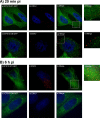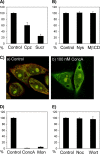Cell entry of the aphthovirus equine rhinitis A virus is dependent on endosome acidification
- PMID: 20375159
- PMCID: PMC2876639
- DOI: 10.1128/JVI.02375-09
Cell entry of the aphthovirus equine rhinitis A virus is dependent on endosome acidification
Abstract
Equine rhinitis A virus (ERAV) is genetically closely related to foot-and-mouth disease virus (FMDV), and both are now classified within the genus Aphthovirus of the family Picornaviridae. For disease security reasons, FMDV can be handled only in high-containment facilities, but these constraints do not apply to ERAV, making it an attractive alternative for the study of aphthovirus biology. Here, we show, using immunofluorescence, pharmacological agents, and dominant negative inhibitors, that ERAV entry occurs (as for FMDV) via clathrin-mediated endocytosis and acidification of early endosomes. This validates the use of ERAV as a model system to study the mechanism of cell entry by FMDV.
Figures




Similar articles
-
Equine Rhinitis A Virus Mutants with Altered Acid Resistance Unveil a Key Role of VP3 and Intrasubunit Interactions in the Control of the pH Stability of the Aphthovirus Capsid.J Virol. 2016 Oct 14;90(21):9725-9732. doi: 10.1128/JVI.01043-16. Print 2016 Nov 1. J Virol. 2016. PMID: 27535044 Free PMC article.
-
Equine rhinitis A virus and its low pH empty particle: clues towards an aphthovirus entry mechanism?PLoS Pathog. 2009 Oct;5(10):e1000620. doi: 10.1371/journal.ppat.1000620. Epub 2009 Oct 9. PLoS Pathog. 2009. PMID: 19816570 Free PMC article.
-
Persistence and chronic urinary shedding of the aphthovirus equine rhinitis A virus.Comp Immunol Microbiol Infect Dis. 2013 Jan;36(1):95-103. doi: 10.1016/j.cimid.2012.10.003. Epub 2012 Nov 24. Comp Immunol Microbiol Infect Dis. 2013. PMID: 23183058
-
Equine picornaviruses: well known but poorly understood.Vet Microbiol. 2013 Nov 29;167(1-2):78-85. doi: 10.1016/j.vetmic.2013.05.012. Epub 2013 Jun 10. Vet Microbiol. 2013. PMID: 23820049 Review.
-
Cellular receptors for foot and mouth disease virus.Intervirology. 2009;52(4):201-12. doi: 10.1159/000226121. Epub 2009 Jun 24. Intervirology. 2009. PMID: 19556802 Review.
Cited by
-
Membrane Interactions and Uncoating of Aichi Virus, a Picornavirus That Lacks a VP4.J Virol. 2022 Apr 13;96(7):e0008222. doi: 10.1128/jvi.00082-22. Epub 2022 Mar 16. J Virol. 2022. PMID: 35293769 Free PMC article.
-
Equine Rhinitis A Virus Mutants with Altered Acid Resistance Unveil a Key Role of VP3 and Intrasubunit Interactions in the Control of the pH Stability of the Aphthovirus Capsid.J Virol. 2016 Oct 14;90(21):9725-9732. doi: 10.1128/JVI.01043-16. Print 2016 Nov 1. J Virol. 2016. PMID: 27535044 Free PMC article.
-
Limits of structural plasticity in a picornavirus capsid revealed by a massively expanded equine rhinitis A virus particle.J Virol. 2014 Jun;88(11):6093-9. doi: 10.1128/JVI.01979-13. Epub 2014 Mar 19. J Virol. 2014. PMID: 24648455 Free PMC article.
-
Thermostability of the Foot-and-Mouth Disease Virus Capsid Is Modulated by Lethal and Viability-Restoring Compensatory Amino Acid Substitutions.J Virol. 2019 May 1;93(10):e02293-18. doi: 10.1128/JVI.02293-18. Print 2019 May 15. J Virol. 2019. PMID: 30867300 Free PMC article.
-
Picornavirus RNA is protected from cleavage by ribonuclease during virion uncoating and transfer across cellular and model membranes.PLoS Pathog. 2017 Feb 6;13(2):e1006197. doi: 10.1371/journal.ppat.1006197. eCollection 2017 Feb. PLoS Pathog. 2017. PMID: 28166307 Free PMC article.
References
-
- Bayer, N., D. Schober, M. Huttinger, D. Blaas, and R. Fuchs. 2001. Inhibition of clathrin-dependent endocytosis has multiple effects on human rhinovirus serotype 2 cell entry. J. Biol. Chem. 276:3952-3962. - PubMed
-
- Benmerah, A., M. Bayrou, N. Cerf-Bensussan, and A. Dautry-Varsat. 1999. Inhibition of clathrin-coated pit assembly by an Eps15 mutant. J. Cell Sci. 112(Pt. 9):1303-1311. - PubMed
Publication types
MeSH terms
Substances
Grants and funding
- G0200504/MRC_/Medical Research Council/United Kingdom
- BB/E00931X/1/BB_/Biotechnology and Biological Sciences Research Council/United Kingdom
- BBS/E/I/00001411/BB_/Biotechnology and Biological Sciences Research Council/United Kingdom
- BB/D524875/1/BB_/Biotechnology and Biological Sciences Research Council/United Kingdom
- G0600025/MRC_/Medical Research Council/United Kingdom
LinkOut - more resources
Full Text Sources
Other Literature Sources

